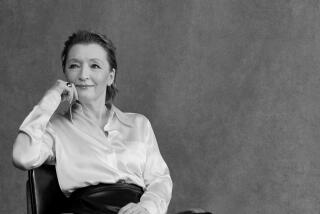Kerr Looks Back on a ‘Damn Good’ Job
- Share via
“I sat and watched the whole thing with my three grandchildren, who absolutely loved it, and I thought, ‘It can’t have been that long ago. And damn good it is, too!’ Let’s have a little ego this evening.”
Deborah Kerr is speaking of the 1956 film musical “The King and I,” in which she starred as English governess Anna Leonowens opposite Yul Brynner as the Siamese monarch. Kerr, whose genteel British-accented tone sounds gracious and not even remotely egotistic, is on the phone from Klosters, the Swiss mountain village where she and her husband, novelist-screenwriter Peter Viertel, have lived during most of their 31-year marriage. She has returned from her garden, a favorite pastime since retiring from the screen in 1969.
Though she has recorded a radio commercial for this weekend’s Hollywood Bowl screenings of “The King and I,” Kerr will not be present, she says, because she is busy planning her 70th birthday celebration on Sept. 30. The film, for which she received one of her Oscar nominations, is among her favorites.
Kerr terms it “frightfully difficult” to choose a favorite number from the movie’s classic Rodgers and Hammerstein score. Perhaps most memorable to enact, though, was “Shall We Dance?” in which Anna teaches the King the polka as their romantic feelings grow. Though the on-screen dance is exhilarating to watch, its filming, Kerr says, was anything but carefree.
“Boy, was that exhausting! We did it slowly at first, because Yul had only one lung. He had an oxygen dispenser standing by in the wings, and once he said, ‘Come on, you try. Have a whiff.’ Well, it just made me almost faint, because it went to my head.
“A lot of the scene was one long (continuous) shot, from a crane. It was hard, with the heavy, heavy hoops on my skirt, which were made of metal. They swung out at every turn and bruised my legs and waist. And my hip bones, where the top of the metal skirt attached, were black and blue.”
In the years since the film’s release, it’s become common knowledge that singer Marni Nixon performed Kerr’s vocals. Though Kerr gave Nixon credit at the time, Nixon recently told a television interviewer that her own contract forbade her from publicizing the fact.
“I didn’t know that was in her contract,” Kerr says when informed of this. “I would have given them hell. I was delighted that Marni was doing it, because she was a charming person with a lovely voice and a wonderful talent for imitating me.
“We rehearsed a great deal at blending, with me starting”--she sings part of the “Shall We Dance?” introduction to illustrate--”and Marni taking off without separation. I’d be on one microphone and she’d be on the other. It was important, too, that she understood my interpretation of the role, why I made a certain inflection.”
The movie took about six months to film, Kerr says. “I never wanted it to end. We finished at Christmastime. We had an enormous Christmas tree with all Siamese toys for the children. Everyone was in floods of tears--we couldn’t believe that on Monday we wouldn’t be getting together again.”
Other than Brynner, who died Oct. 10, 1985, Kerr has not remained in touch with any of her “King and I” colleagues. “I’ve never seen most of them again. But when I was playing ‘The Day After the Fair’ in Los Angeles (at the Shubert in 1973), the stage door man said, ‘There’s a gentleman who wants to see you. He doesn’t think you’ll remember his name (Patrick Adiarte), but he played the Crown Prince in ‘The King and I.’
“I said, ‘Yes, have him come in.’ I was expecting,” she recounts with a wry laugh, “a 15-year-old boy. And I see a 32-year-old gentleman with two children!”
More to Read
Only good movies
Get the Indie Focus newsletter, Mark Olsen's weekly guide to the world of cinema.
You may occasionally receive promotional content from the Los Angeles Times.









